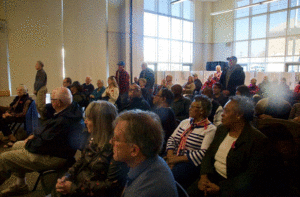By DANDAN ZOU
Wearing red paper-made poppies, dozens of people listened to a short account of the lives of 18 Calvert men who died in World War I on Saturday at Calvert Library Prince Frederick. The event celebrated the 100th anniversary of the end of a war that killed millions and inflicted destruction on families and communities worldwide.
As the crowd reflected on the meaning of war and peace, they were reminded of the supreme sacrifice made by the men and women who lost their lives fighting for liberty and freedom.
“For those of you that are service people, you know that warriors die twice,” George Owings III, Maryland Veterans Affairs secretary, said Saturday.
The first time was the physical death that either occurred on the battlefield or in the hospital as a result of the war, he said. The second death is the last time a warrior’s name is ever spoken.
“The point is this, friends: They have not died,” he said, referring to the 18 Calvert men who died in WWI. “They are still very much alive in the hearts of those that take the time to read their names and reflect.”
Their names are George Armiger, Solomon Barnes, Alonza Brown, James Butler, Wallace Curtis, William T. Dorsey, Thornton Gormon, John Gross, Joseph S. Jones, Benjamin Kent, Arick L. Lore, William N. Marquess, Thomas J. Osborne, Reuben Pitcher, Murray A. Sherbert, Irving R. Stallings, Harry Sunderland and Charles W. Tongue.
In total, 315 men and women from Calvert County enlisted to fight in the war. One of the 18 men killed during the war died three weeks after returning from battle.
The names of the 18 men are engraved on an 8-foot-tall statue that stood in front of the courthouse that hosts the county’s circuit court.
“The statue represents the ‘Dawn of Victory.’ It is a figure of a woman in a helmet and breast plate of armor with the rays of the rising sun bursting behind her,” said Joyce Baki, who researched the topic and spoke at Saturday’s event. “It is to represent the brilliance of America’s entrance into the great world conflict.”
The statue was dedicated Nov. 11, 1920, two years after the war ended.
Baki said the American Legion Calvert Post 85 oversaw the ceremonies of the dedication, and it was the first American Legion established in Calvert County.
In remembrance of those who died from the war, Michael Kent, president of Calvert’s NAACP, told the audience that his organization asked local churches if they would like to “adopt” the seven black soldiers who died in the war. It means a church would host the information of one solider and citations from politicians to honor their sacrifice.

